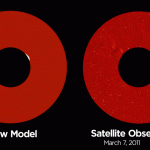Scientists evade the Heisenberg uncertainty principle0
- From Around the Web, Science & Technology
- March 24, 2017
Researchers report the discovery of a new technique that could drastically improve the sensitivity of instruments such as magnetic resonance imagers (MRIs) and atomic clocks. The study reports a technique to bypass the Heisenberg uncertainty principle. This technique hides quantum uncertainty in atomic features not seen by the instrument, allowing the scientists to make very high precision measurements.
















